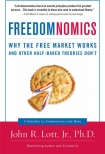Freedomnomics: Why the Free Market Works and Other Half-Baked Theories Don't John Jr. (the dot read aloud .txt) 📖

- Author: John Jr.
Book online «Freedomnomics: Why the Free Market Works and Other Half-Baked Theories Don't John Jr. (the dot read aloud .txt) 📖». Author John Jr.
Let’s begin by looking at the overall status of abortion in the United States in the early 1970s. This is when Donohue and Levitt find that the “legalization” of abortion laid the foundation for the future drop in crime. It should be noted that, contrary to popular belief, there was not a blanket ban on legal abortion before the early 1970s. While closely regulated, the procedure was legal in various circumstances, such as when the life or health of the mother was at risk. In some states, doctors interpreted this clause quite liberally. As a result, legal abortion was much more widespread before Roe v. Wade than is commonly acknowledged. In fact, in 1970-1973, when abortion was “legal” in five states but “banned” in the rest, some of the “banned” states had similar or even higher rates of legal abortion than in the “legal” states. For example, Kansas had 277 abortions per 1,000 live births in 1971, outstripping “legal” states such as Alaska (160), Hawaii (261), and Washington (265). High rates of abortion could be found in other “banned” states and districts, such as Washington, D.C. (703), New Mexico (219), and Oregon (206).24 Donahue and Levitt, whose main results mistakenly assumed that no legal abortions occurred in any of the “banned” states before 1973, thus began their study with flawed statistics.25
A central problem with the “abortion reduces crime” thesis is that it conflates and blurs two different arguments. The first contention is that aborted children would have been more likely to cause crime specifically because they’re unwanted—since their parents did not wish to have them, they would likely have grown up in an unloving household, and would have therefore been more prone to crime. A separate, less savory explanation is that abortion reduces crime by culling out certain demographic groups that commit disproportionate numbers of crime, for example, young African American males. If abortion really reduces crime, then this “eugenics” effect could be highly significant, since African Americans have an abortion rate that has consistently been about three times that of whites and a murder rate about 6.5 times that of whites.26
While their discussion emphasized the “unwanted child” theory, Donohue and Levitt never separated it from the eugenics approach, which was left without refutation in their work.27 Indeed, Donahue and Levitt seem to have deliberately avoided the racial implications of their own theory, as their inquiry is one of the few academic studies on crime by economists that doesn’t account for these demographics. Perhaps this was just too explosive to mention; after all, who would dare to state that abortion lowers crime rates by reducing the population of poor African Americans?28
The relationship between abortion and crime is complex. We must begin by considering the circumstances and expectations under which a woman becomes pregnant. Remember the fundamental principle of economics: if something becomes more costly, people do less of it. If abortion is illegal, the “cost” of sex is relatively high due to the possibility of pregnancy. No method of birth control is 100 percent effective, and without the option to have an abortion as a last-ditch safeguard, having sex carries a risk. When contemplating having pre-marital sex, women know that they might have to bear and raise a child, possibly on their own. Likewise, men know that they might end up having to support a child, and both know that having a baby could create pressures on them to marry even if they don’t want to do so. Consequently, both men and women tend to be more reluctant to engage in casual sex, especially unprotected sex, when abortion is illegal.29
In contrast, if abortion is legal, the incentives are different. Knowing that the abortion option is there to save them from raising an unexpected child, women who are willing to have an abortion—as well as men in general—become less concerned with contraceptives and more likely to engage in premarital sex. As more women have premarital sex, social mores become more accommodating to the practice. This creates social pressure on other women to have premarital sex, including women who would never have an abortion. Increasing rates of premarital sex among these latter women leads to higher pregnancy rates. The result is rising numbers of women who are single, pregnant, and unwilling to have an abortion.
Indeed, multiple studies have shown that legalized abortion, by raising the rate of unprotected premarital sex, increases the number of unplanned births, even outweighing the reduction in unplanned births due to abortion.30 From the early 1970s, when abortion was liberalized, through the late 1980s, there was a tremendous increase in the rate of out-of-wedlock births, rising from an average of 5 percent in 1965-69 to over 16 percent twenty years later (1985-1989). For African Americans, the numbers jumped from 35 percent to 62 percent. While not all of this rise can be attributed to liberalized abortion rules, it was nevertheless a key contributing factor.
Let’s return to the personal level. In an environment of legal abortion, a man might well expect his partner to have an abortion if a sexual encounter results in an unplanned pregnancy. But what happens if the woman refuses? Maybe she is morally opposed to abortion, or perhaps she thought she could have an abortion, but upon becoming pregnant, she decides that she can’t go through with it. What happens then?
Many men, feeling tricked into unwanted fatherhood, will likely wash their hands of the affair altogether, thinking “I never wanted a baby; it’s her choice, so let her raise the baby herself.” What is expected of men in this position has changed dramatically in the last four





Comments (0)